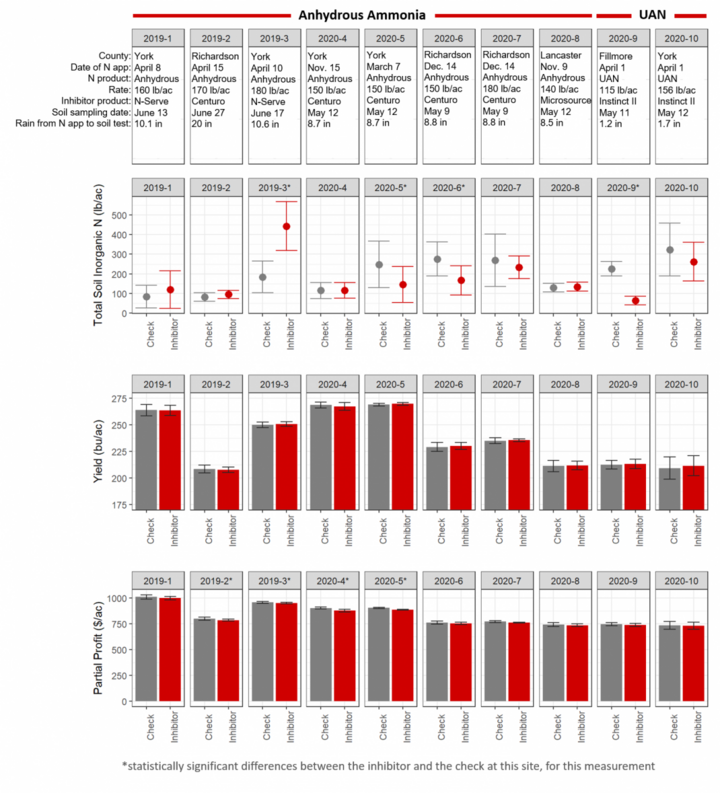How Do Nitrification Inhibitors Work?
Ammonium (NH4+) is a positively charged ion (cation) that can be held on the negatively charged clays and organic matter in the soil. The negatively charged nitrate (NO3-) anion can result in N2O gas emissions under limited oxygen conditions or leach below the root zone with rain in well-drained soils. Nitrification inhibitors contain compounds that reduce populations of the bacteria responsible for converting ammonium to nitrite (Nitrosomonas) and nitrite to nitrate (Nitrobacter). This protects against both denitrification and leaching nitrogen losses by retaining fertilizer N in the more stable ammonium form.
Common Nitrification Inhibitor Products
Products with known efficacy for inhibiting nitrification are dicyandiamide (DCD), nitrapyrin and pronitradine. Nitrapyrin is sold as N-Serve™ and Instinct™, and pronitradine is sold as Centuro™. Nitrapyrin and DCD are not patent protected and may be found in a variety of products.
Efficacy
While many inhibitor products have been shown to perform as advertised in inhibiting nitrification, such protection may not translate into yield or profit benefits. If weather and soil conditions are not conducive to N loss, inhibitors do not provide a benefit. Additionally, if N rates are excessive, N loss can occur but have no impact on yield. Therefore, in cases of excessive N rates, there may be no benefit from the use of inhibitors. Soil type may also play a role in the ability of nitrification inhibitors to reduce leaching and provide yield benefits. A 20-year study found the use of nitrification inhibitors was not effective in reducing leaching for a silt loam soil in Nebraska, while the application of excessive fertilizer-N had a great effect. This indicates less potential for nitrification inhibitors to reduce nitrate leaching for silt loam, silty clay loam, and finer textured soils. This is likely due to less water percolation below the root zone compared with sandier soils.
Results of On-Farm Research Evaluations in Nebraska in 2019 and 2020

In 2019 and 2020, on-farm research studies evaluating inhibitors were conducted by Nebraska farmers participating in the Nebraska On-Farm Research Network. This article summarizes the results of 10 studies which used similar inhibitor products. Of these 10 studies, four were conducted with fall applied anhydrous ammonia, four were conducted with spring applied anhydrous ammonia and two were conducted with in-season UAN applications. The studies were conducted in York, Richardson, Lancaster and Fillmore counties with soil textures ranging from silt loam to silty clay loam. The inhibitor products used were N-Serve, Centuro and Microsource DCD for the anhydrous applications and Instinct II for the UAN applications. Total soil inorganic N (NH4 + NO3), yield and profitability data were collected (Figure 1).
Soil NH4 and NO3 samples were taken in both the inhibitor and check treatments at a 1’ depth. In 2019, the sampling date was in mid-June. In 2020, the sampling dates were in mid-May. At one site (2019-3), higher total soil inorganic N (NH4 + NO3) for the inhibitor treatment was observed when compared to the check. At the remaining sites, total soil inorganic N was the same with and without the inhibitor, or it was lower with the inhibitor.
Yield was not impacted by using the inhibitor at any of the 10 research sites.
Partial profit was evaluated by considering yields and selling price for both the inhibitor and the check and the cost of the inhibitor product (for the inhibitor treatment) as follows:
Partial profit for check = Yield (bu/ac) X Price ($/bu)
Partial profit for inhibitor treatment = Yield (bu/ac) X Price ($/bu) – cost of inhibitor ($/ac)
For four of the sites, partial profit was statistically lower where the inhibitor was used (2019-2, 2019-3, 2020-4, 2020-5). At the remaining sites, there were no differences in partial profit between the inhibitor and check treatments (Figure 1).
Weather and Soil Impacts on Efficacy
Nitrification inhibitors break down over time and will no longer be effective. The rate of breakdown is influenced by temperature. Products generally remain effective longer at cooler soil temperatures, with efficacy ranging from two to several weeks. As such, multiple years of research under varying weather conditions are needed to determine the impact of these products on yield and profit.
Additionally, the previous studies were conducted on finer textured soils (silt loams and silty clay loams); however, it is likely that greater returns may be seen using these products on coarser textured soils. Therefore, continuing with more sites on courser textured soils is of particular interest.
Next Steps
On-farm research studies evaluating inhibitors will continue over the next several years as part of the Precision Nitrogen Management on-farm research project. In 2021, there are currently six on-farm studies underway to evaluate the impact of inhibitors on corn and two on-farm studies underway to evaluate the impact of inhibitors on wheat.
Are you curious about how inhibitors might work on your farm? The Nebraska On-Farm Research Network can help you generate reliable data and evaluate the impact of these products in your own farm operation. Eligible cooperators who participate in these studies as part of the Precision Nitrogen Management project will receive compensation for their study.
Additional Resources
Bastos, Leonardo, Bijesh Maharjan, Charles Wortmann, and Richard Ferguson. April 19, 2018. Nitrogen Fertilizer Stabilizers in Corn. UNL CropWatch.
Hansel, F.D. and D.A. Ruiz Diaz. 2019. Corn Yield Response to the Use of a Nitrification Inhibitor with Anhydrous Ammonia. Kansas Agricultural Experiment Station Research Reports: Vol. 5: Iss. 4.
Ferguson, Richard, Bijesh Maharjan, Charles Wortmann, and Brian Krienke. January 14, 2019. Nitrogen Inhibitors for Improved Fertilizer Use Efficiency. UNL CropWatch.
Wortmann, Charles, Laila Puntel, Javed Iqbal, and Bijesh Maharjan. Jan. 7, 2020. Agronomic Management for Reduced Nitrate Leaching. UNL CropWatch.

